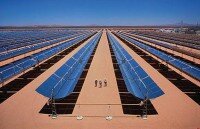The power of Israeli sunshine
Posted in Policy, Technology on 05/14/2009 11:57 am by Stephen Tindale Israel is a world leader in solar energy. About three quarters of all households use the sun to heat water, using a technology called solar thermal. And Israeli firms are widely recognised as technological leaders in the field of solar electricity.
Israel is a world leader in solar energy. About three quarters of all households use the sun to heat water, using a technology called solar thermal. And Israeli firms are widely recognised as technological leaders in the field of solar electricity.
However, Israel could and should be doing much more. This is not just to help control climate change despite the fact that climate change is clearly the greatest threat humanity has ever faced. Rather (and understandably), people living in Israel may legitimately feel that other threats are more immediate. In this context, expanding solar power would help Israel’s energy security by reducing – and ultimately removing – the need to import coal and oil. Community solar schemes could also help build links, perhaps even in Gaza, with groups and individuals interested in human progress rather than enmity.
At the moment, Israel imports about 85% of its energy. Its electricity is almost entirely from fossil fuels, mainly coal. Yet it has no coal, so imports huge quantities every year – with South Africa being the main supplier. It has plenty of natural gas (and is stepping up offshore exploration to find more). Therefore, since 2002, gas has been introduced into the electricity generation mix, leading to a reduction in oil used for generation. However, oil is still used for generation of electricity, as well as for transport fuel, and Israel has virtually none of its own. Oil suppliers include Egypt, Angola, Mexico, Colombia and Norway, and (more recently) Russia and Kazakhstan.
As mentioned above, Israeli firms are recognised as technological leaders in solar energy. For example, BrightSource signed a major deal with a US company in February to create a solar power plant in Southern California, which will generate enough electricity for almost a million homes. A much smaller plant (one-fifth of the Californian one) is also planned for Israel’s Negev Desert.
However, the free market does not deliver renewable energy, as the cost is still higher than for fossil fuel energy. But the reason why Israel has done well on solar thermal is simple. Since 1980, it has been mandatory for all new buildings (except hospitals and industrial buildings) to be fitted with solar thermal panels. Unfortunately, there have been no such measures for solar electricity. The Israeli government set targets in 2002 for 2% of electricity to come from renewables by 2007, rising to 5% by 2016. But targets alone are irrelevant and this one made little difference. By the end of 2008, only 0.01% of Israeli electricity came from renewables. Nevertheless, in January 2009, the government announced more ambitious targets: 5% by 2014 and 10% by 2020. These are still quite modest targets. For comparison, the EU agreed, in December 2008, a target of 20% of all energy (that is, electricity, heat and transport) to come from renewables by 2020.
Therefore, Israel has a major challenge to expand its electricity generation over the next decade. As explained above, fossil fuels, other than gas, must be imported and all power stations using these fuels require very large quantities of water, which is increasingly in short supply in Israel. In addition, the Israeli government announced in January 2008 that it would install the world’s first electric car network, in 2011. This is ambitious and admirable but, if met, will require even more electricity.
Therefore, to put it bluntly, for energy independence, economic, social and climate reasons, Israel must move quickly to harness a natural resource that it has in abundance: sunlight.

